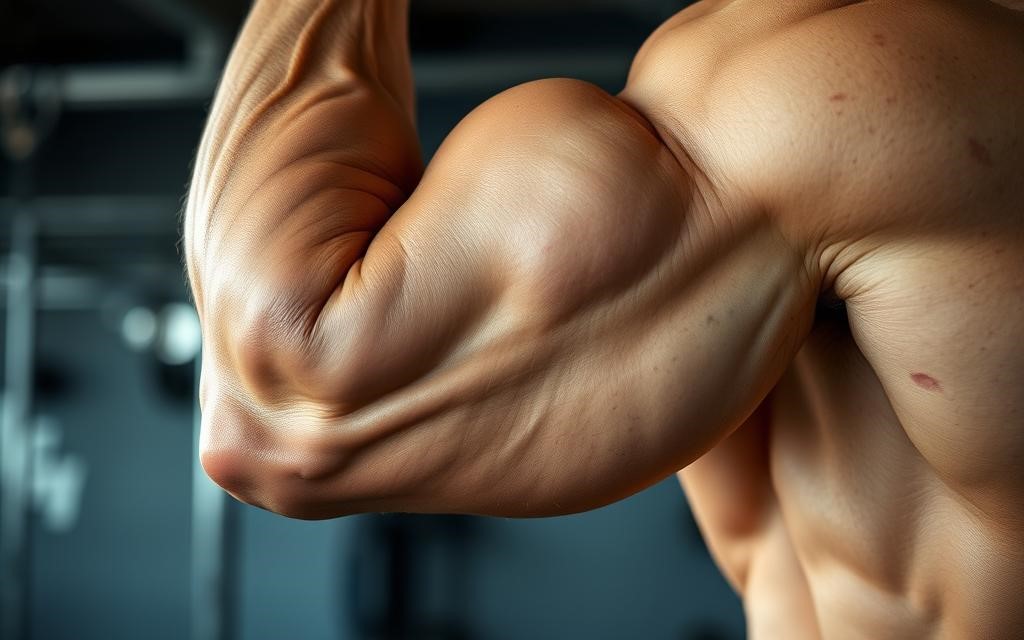Can Open Close Arm After Workout Bicep Heal Fast Bcops
After a tough workout, it’s common to wonder, ‘Can open close arm after workout bicep heal fast bcops?’ Experiencing soreness and stiffness in your biceps can make it difficult to move your arms freely, which can hinder your ability to maintain a regular workout routine. Understanding how to heal your biceps quickly and regain full arm movement is crucial for effective recovery and continued progress.
This article will cover bicep recovery, what affects healing speed, and how to heal muscles quickly.
Key Takeaways
- Bicep soreness and restricted arm mobility are common after intense arm workouts.
- Factors like exercise type, fitness level, nutrition, and sleep affect the speed of bicep recovery.
- Active recovery techniques, proper hydration, and soft tissue therapy can help accelerate bicep healing.
- Gradual workout progression and correct form are key to preventing excessive bicep soreness in the future.
- Consulting a healthcare professional is advised if the bicep injury is severe or persistent.
Understanding Bicep Soreness and Restricted Arm Mobility
Muscle repair happens after a tough bicep workout. It makes your muscles stronger and bigger as they heal tiny tears. Delayed Onset Muscle Soreness (DOMS) is a soreness that goes away 24 to 48 hours after working out. It can make simple tasks like opening and closing your arms painful.
Recognizing and Treating Bicep Soreness
Wondering why you can’t open or close your arms after a workout? Knowing how to recover from bicep exercises can help. Bicep soreness remedies and arm recovery exercises can ease the pain and improve your arm’s movement.
Delayed Onset Muscle Soreness (DOMS) and its Effects
DOMS is common after a tough bicep workout. It can make simple tasks hard, like reducing bicep pain after exercise. This soreness is a sign that your muscles are repairing and getting stronger. It’s key to handle it right to prevent bicep injury during workout and recover faster.
“Proper nutrition and hydration, along with active recovery techniques, can significantly reduce the duration and intensity of bicep soreness.”
By knowing why bicep soreness happens and using the right recovery methods, you can lessen the pain. You’ll also get your arm moving better and get back to working out sooner.
Factors That Influence Bicep Recovery Time
Many things can affect how long it takes for bicep soreness to go away after a tough workout. Knowing these can help you speed up muscle repair and get your arms moving freely again.
Exercise Type and Intensity
The kind of exercises you do and how hard you do them can really affect bicep soreness. Heavy lifting, like bicep curls or pull-ups, causes more damage and soreness. Workouts that really push your biceps will take longer to recover from than easier ones.
Fitness Level and Adaptation
Your fitness level and how your body adjusts to strength training are key to recovery. Newbies to resistance training or those who’ve been away from bicep exercises may feel more sore and stiff. As you get more experienced, your muscles get better, and recovery gets faster.
Diet, Hydration, and Sleep
Good nutrition, staying hydrated, and enough sleep are vital for muscle repair. Protein helps rebuild muscle, and carbs refill energy stores. Drinking water helps avoid muscle stiffness and cramps. Quality sleep lets your body recover fully for the next workout.
“Adequate recovery is just as important as the workout itself for building muscle and improving arm mobility. Pay attention to the factors that influence your bicep healing and make adjustments accordingly.”
Tips to Speed Up Bicep Healing and Restore Arm Mobility
After a tough bicep workout, your arms may feel sore and stiff. But don’t worry, there are ways to speed up healing and get your arms moving again. Let’s look at some effective strategies:
Active Recovery Techniques
Doing light activities like walking, stretching, or easy cycling can help with active recovery for biceps. It boosts blood flow, removing waste and bringing nutrients to the muscles. This makes healing faster. Studies show it can also lessen muscle soreness and help you move your arms better after a workout.
Proper Nutrition and Hydration
Good nutrition for bicep recovery is key. Drinking lots of water before, during, and after working out helps muscles recover. Also, eating foods high in protein or taking protein shakes can help fix muscle damage.
Massage, Foam Rolling, and Muscle Release Techniques
Massage and foam rolling can ease muscle tightness and boost blood flow. They help loosen muscle knots, improve flexibility, and shorten soreness for sore biceps. Plus, foam rolling for bicep pain can ease discomfort and aid in quicker healing.
By adding these steps to your post-workout routine, you’ll help your biceps heal faster and regain full arm mobility. Remember, sticking to these practices regularly is important for your fitness journey.
Can Open Close Arm After Workout Bicep Heal Fast Bcops
After a tough workout, your biceps might feel stiff and hard to move. It’s normal to find it tough to open and close your arms. This can be frustrating if you love working out regularly. To recover well and keep improving, you need to know how to heal fast and move your arms freely again.
Getting your biceps to recover right is key for your arm’s health and movement. The good news is there are ways to make your arms heal quicker. By knowing what affects bicep recovery and using the right recovery methods, you can quickly get back to your workouts.
- Do gentle stretching and light cardio to help blood flow and ease stiffness.
- Eat a diet rich in protein and drink plenty of water before, during, and after working out.
- Try massage, foam rolling, and other muscle release methods to ease soreness and improve flexibility.
Being patient and consistent is important for bicep recovery. With a good recovery plan, you can can open close arm after workout, regain arm flexibility after workout, and bicep heal fast. This lets you confidently return to your fitness routine, with less chance of injury.
“Recovering from a bicep injury is all about taking a holistic approach to your body’s needs. By addressing factors like nutrition, hydration, and active recovery, you can fast bicep recovery and get back to your training routine stronger than ever.”
When to Seek Professional Help for Bicep Injuries
Post-workout bicep soreness is normal. But, sometimes you need professional help. Severe pain, swelling, bruising, or losing strength could mean a serious injury. This could be a bicep tear or strain.
Signs of a Serious Bicep Injury
Watch for these signs of a serious bicep injury:
- Severe, persistent pain in the bicep area
- Visible swelling or bruising around the bicep
- Difficulty bending or straightening the arm
- Significant loss of strength or limited range of motion in the affected arm
If you see these signs of bicep tear, get medical help fast. This prevents more damage and helps with healing.
Benefits of Consulting a Healthcare Professional
Talking to a healthcare professional or physical therapist is smart if you think you have a serious bicep injury. They can check you, find out how bad the injury is, and make a recovery plan just for you. This helps you heal faster and get your arm working right again. The benefits include:
- Accurate diagnosis of the injury
- Personalized treatment plan for bicep tear recovery
- Guidance on exercises and activities for healing
- Monitoring progress and adjusting the plan as needed
- Less chance of more injury or long-term problems
By consulting a healthcare professional for your bicep injury, you get a safe and effective recovery. This lets you get back to your workouts and activities with confidence.
Preventing Excessive Bicep Soreness in Future Workouts
To avoid too much soreness and speed up recovery, try a few things. Start with a good warm-up and cool-down. Also, increase your workout intensity slowly and focus on doing exercises right.
Proper Warm-Up and Cool-Down Routines
A good warm-up gets your muscles ready for the workout. Do arm swings, light cardio, and mobility exercises. This boosts blood flow, reduces injury risk, and improves your workout.
For cool-down, use light stretches and low-intensity exercises. They help remove lactic acid, relax muscles, and lessen soreness after working out.
Gradual Progression and Proper Form
Slowly increase the intensity and volume of your workouts. This lets your muscles get stronger without too much stress. It helps prevent soreness and injury.
Also, always focus on the right form when doing bicep exercises. Correct technique reduces muscle and joint stress. This lowers the chance of soreness and injury.
By following these tips, you can reduce bicep soreness and recover faster. Make these habits part of your workout routine.
Conclusion
It’s normal for your arms to feel sore and stiff after a tough bicep workout. This is because your muscles are repairing and recovering. By knowing why your arms get sore and using the right recovery methods, you can move faster and get stronger.
Key recovery tips include active recovery, eating right, staying hydrated, and using treatments like massage. Being consistent with these practices and listening to your body is key. It helps your arm move freely again and prepares you for more workouts.
Being able to easily open and close your arms after a workout means your biceps have fully recovered. With patience and dedication to your health, you’ll be moving your arms with ease soon. Keep up the good work and seek medical help if you have ongoing issues.
FAQ
What causes discomfort and restricted range of motion in the biceps after a workout?
After a tough workout, it’s common to feel sore and stiff in your biceps. This is because your muscles are healing and experiencing delayed onset muscle soreness (DOMS).
How does DOMS affect the ability to open and close the arms after a workout?
DOMS can make simple actions like opening and closing your arms painful. It’s a type of soreness that usually fades within 24 to 48 hours after exercising.
What factors influence the speed of bicep recovery?
Several things can impact how quickly your biceps recover. These include the exercises you did, how intense your workout was, and your fitness level.
How can proper hydration and nutrition support bicep recovery?
Drinking enough water and eating well are key for muscle repair. Protein helps rebuild muscle fibers, and carbs replenish energy stores, aiding in recovery.
What active recovery techniques can help speed up bicep healing?
Doing light activities like walking, stretching, or cycling can help. These activities improve blood flow, removing waste and bringing nutrients to the muscles for repair.
When should you seek professional help for a bicep injury?
If you have severe, ongoing pain, swelling, bruising, or a big drop in strength, it might be a serious injury. A healthcare professional or physical therapist can help diagnose and treat it.
How can you prevent excessive bicep soreness in future workouts?
To avoid too much soreness, warm up properly, gradually increase workout intensity, and keep your form right. These steps can help prevent excessive soreness and speed up recovery.

